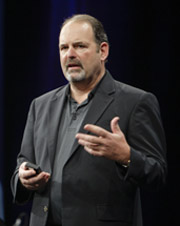Federal CIO Scott plots to counter ‘severe talent shortage’
Tony Scott, the federal chief information officer, said agencies need to build from within to address talent gaps throughout the government.
No matter where Tony Scott has worked during his career, recruiting and retaining talented technology workers has been a growing problem.
In his seven months as federal chief information officer, Scott said the government’s challenges are similar to those he faced in the private sector, whether it was with VMWare or Microsoft or Disney.

“It’s particularly acute in the cyber area,” Scott said Wednesday during a live presentation of Federal News Radio’s Ask the CIO program at the 930gov conference in Washington. “It’s the hardest recruiting I’ve ever done, whether it was in the private sector or the public sector. The good news is there’s a lot of people who are now interested in doing good things for the country and we are getting a lot of unsolicited resumes and people who say, ‘Can I come help? This seems like a very important thing and I’d like to be a part of it and help work on it.’ I think it’s true across all of IT as well. Right now there is a severe talent shortage in some roles across the whole IT industry. I think we have to do more as a federal government to recruit, retrain and build from within to get the kind of resources we need to do this important work.”
To help address these shortages, Scott said he plans to work with the CIO Council in September and October to initiate two programs.
First, the council will launch a second IT Solutions Challenge. OMB and the CIO Council kicked-off the inaugural effort in March with a goal of finding IT and acquisition professionals at the General Schedule 9 through 13 levels for a six-month program to identify and fix policy and process problems in how the government buys technology.
Over the last five months, the 39 participants from 17 agencies split into five teams and have been working on a range of programs such as cross-agency collaboration and interoperability of interagency networks and career development, recruitment and retention of IT professionals.
“We did the solutions challenge with a couple of objectives in mind,” Scott said. “The first one was we wanted to identify some of the developing talent in the agency so each of the agencies were asked to pick people to be a part of that initial group. Then we got them together and there is benefit from that peer group exchanging ideas and getting to know each other. Then we asked them to pick out some big challenges they see in the federal government IT ecosystem and develop recommendations for those issues. We are getting near the end of that now. We are pretty excited about some of the opportunities and we will put people to work those ideas we select at the end.”
He declined to offer more details about those recommendations, but said the teams have done really good work and is excited about where it goes from here.
“We will use this as an opportunity to learn and then we’ll do another one, maybe with a slightly different theme, but I’m committed to making sure we are committed to developing talent in the agencies and within the federal government,” Scott said.
The council’s focus on the IT workforce isn’t new, but it has been refreshed over the last year.
The council’s workforce committee surveyed CIOs and chief human capital officers and found about 75 percent of the respondents say they couldn’t recruit the necessary talent to do mission critical work.
That is where part two of Scott’s plan comes in.
“The look I want to have is across a couple of dimensions,” Scott said. “The first one is who are the folks we think are the promising leaders coming through the system, and then what are the development opportunities each of those people need to round out their experiences. Once you understand what the individual needs, you can also look at what are the roles within the federal government that could satisfy those needs, and you do a little matchmaking and try to get those people those experiences over time. One of the things we will also do is try to do a higher level assessment of where do we have gaps in talent. I can already tell you cyber is one of those areas already. This would be no surprise to anybody. We think the sheer number of people we have — and this isn’t saying anything about their skills — probably isn’t sufficient to meet the demand today. So we will also talk about different levers we can bring in to develop more of that talent.”
Scott also reiterated the need not just to bring in new employees, but take advantage of the talent that exists in government already.
He said in the private sector, he would run a lot of talent development and succession planning activities in a structured way to make sure the company was developing talent it needed from within. Scott said then you supplement that with people from the outside.
“In government, I think we need more of that kind of development,” he said. “There is always some balance between the individual taking personal responsibility for their own development and then the things structurally the institution can do to help make sure there is a good balance and the right opportunities to present themselves.”
Copyright © 2025 Federal News Network. All rights reserved. This website is not intended for users located within the European Economic Area.
Jason Miller is executive editor of Federal News Network and directs news coverage on the people, policy and programs of the federal government.
Follow @jmillerWFED
Related Stories




